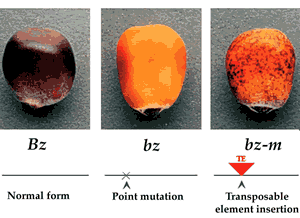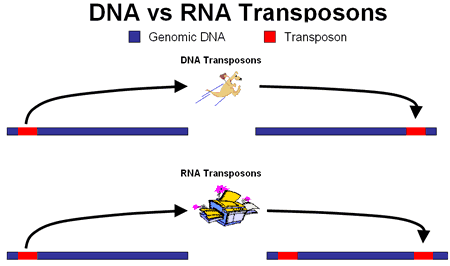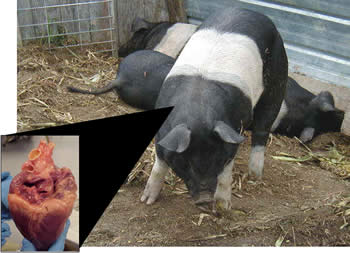 Pretty much everyone who has ever had an e-mail address will have come across "spam", that trickle (or flood) of unsolicited junk e-mail offering to sell you anything from viagra to a share in a dead dictator's fortune. Most of us just delete them with a touch of irritation at their clogging up of our mailboxes, and promptly get on with whatever we were doing. But looking inside ourselves, we discover that this phenomenon pre-dates the internet, and even cave drawings and flint axes. Each cell in our bodies contains thousands of copies of "biological junk mail", except this kind is made of DNA instead of words and data packets. Indeed, while only 2% of our genome directly codes for the proteins that make up our bodies, over 40% of the remaining 'non-coding' DNA is filled with spam! What are these biological "junk mails"?
Pretty much everyone who has ever had an e-mail address will have come across "spam", that trickle (or flood) of unsolicited junk e-mail offering to sell you anything from viagra to a share in a dead dictator's fortune. Most of us just delete them with a touch of irritation at their clogging up of our mailboxes, and promptly get on with whatever we were doing. But looking inside ourselves, we discover that this phenomenon pre-dates the internet, and even cave drawings and flint axes. Each cell in our bodies contains thousands of copies of "biological junk mail", except this kind is made of DNA instead of words and data packets. Indeed, while only 2% of our genome directly codes for the proteins that make up our bodies, over 40% of the remaining 'non-coding' DNA is filled with spam! What are these biological "junk mails"?
They are called transposable elements, or transposons, and are ubiquitous throughout life. They were first discovered by Barbara McClintock in 1944 when, noticing some unusual and changing colour patterns in the kernels of some maize she was studying, she hypothesised the existence of mobile genetic elements to explain the phenomenon (see figure 2, below). With the explosion of molecular biology, much more is now known about these jumping pieces of DNA.
There are two broad classes of transposable elements. DNA-based transposons, which are responsible for the colour changes in maize, move around the genome in a "cut-and-paste" fashion, literally cutting themselves out of their original location and inserting somewhere else. RNA transposons, or retrotransposons as they are also known, work differently. They are thought to originate from viruses that have inserted (integrated) themselves into the genome of a cell they have infected, where they lie dormant and are passively copied along with the host cell's DNA every time the cell divides. Over time, these "sleeping" viruses can mutate, just like any other part of the host's genome, and these mutations can lead to them losing their ability form new virus particles and infect new cells. However, they often retain, at least for a while, the ability to copy themselves, and these copies can, in turn, be inserted somewhere else in the host genome. So while DNA transposons "jump", retrotransposons "copy" themselves to new locations. This is illustrated in figure 3, below.
 |
| Figure 2 : Colour variations in maize caused by DNA transposons. A normal gene (Bz) gives maize kernels a dark colour (left), whereas a mutant version (bz) confers an orange colour (middle). If the gene is disrupted by a transposon (bz-m) this also results in an orange colour, but in some of the cells in the kernel the transposon has jumped back out of the gene, restoring its function, producing dark spots where this has happened (right). |
So what is the point of all these jumping bits of DNA? Can we simply ignore them as a biological oddity, or is it important to understand them? Well, just like the spam we receive by e-mail or post, most of them sit harmlessly in a corner of our genome, but some copy themselves and jump to new locations in our DNA where they affect adjacent genes. In their new location they can disrupt a gene completely, or subtly change the way it exerts its effects in the cell. This can have both positive and negative consequences.
Transposons have undoubtedly been a source of genetic diversity throughout evolutionary time, providing raw material on which natural selection can work. For example, every one of our genes is under the control of another stretch of DNA sequence called a promoter which influences when the gene is turned on and off, and what at level it is expressed. Parts of transposons are known to behave like promoter sequencess and when they jump next to a gene these extra promoter segments can change the way the gene is regulated. If this change happens to be beneficial, it will be selected for in evolution. Indeed this seems to have happened frequently, and it is estimated that 25% of human promoters contain sequences originally from transposons.
In rare cases, single transposons may have had a profound effect on human evolution. The most common transposon in humans is called Alu. Alu elements are DNA transposons found only in primates and seem to have been most active between 30 and 50 million years ago. Researchers have noticed that Alu contains sequence which looks very similar to other parts of the human genome that are regulated by hormone-binding proteins. These are proteins which allow hormones to interface with our DNA, regulating whole sets of genes at once. If Alu's also have this property, then they may have caused widespread changes in the way genes respond to hormones when they jumped near active genes.
Our immune system may also owe a lot to the action of a particular transposon. Our ability to make antibodies to any microbe that infects us relies on a particular set of genes in the B cells of our immune system that can be shuffled around in near-limitless combinations. This means that with a relatively small set of "base" genes, our B cells can produce antibodies on demand against whatever infection we might be facing, without needing one gene for every possible antibody. However, this requires proteins that can "cut-and-paste" DNA to create these new combinations. We've seen this phrase before already ... this is how DNA transposons move around! Scientists have found that the proteins that make our antibody-shuffling system possible, called RAG proteins, entered the genome of our ancestors on a DNA transposon around 450 million years ago. This allowed the jawed vertebrates to adapt their immune responses to each case of disease, a major improvement on the more limited innate immune systems present before.
 |
| Figure 3: DNA and RNA transposons move around the genome. DNA transposons cut themselves out from their original location, and insert themselves somewhere else in the genome. RNA transposons make a copy of themselves that inserts into a new location, leaving the original transposon intact. |
Negative consequences of a transposon jumping into a gene are more likely though. Transposon insertion into a gene can scramble the coding sequence, producing a defective or truncated gene product with little or no function. It can also be detrimental in other ways. Even if it doesn't insert into the coding part of the gene, it can still cause problems, such as altering its regulation in dangerous ways by disrupting the promoter sequence.
 |
| Figure 4: Xenotransplantation - pigs are a potential source of organs. But when scientists transplanted pig organs into mice, they found that a porcine (pig) endogenous retrovirus, which had been dormant in the pig genome, reactivated and infected the mice. |
With more and more genomes being sequenced, transposons can help reconstruct the tree of life. By looking at the pattern of transposons present in different organisms, and how they have mutated over time, inter-relationships between species can be inferred. For example, three ancient retroviral insertions are present in exactly the same places in the genomes of deer, giraffes, hippos and whales. This is just one piece of evidence linking whales to their land-dwelling ancestors.
Transposable elements can also be both a blessing and a curse when it comes to manipulating technology for our own benefit. On the plus side, they are seen as one of a number of possible vectors, or delivery systems, for use in gene therapy. If an efficient way could be developed to smuggle engineered transposons into live human cells in the body, they could be used to deliver healthy copies of a gene that is defective in a patient suffering from a genetic illness.
One area where they can present an obstacle is xenotransplantation, the use of animal organs for human transplants. Pigs in particular are seen as a promising source of donor organs. However, when scientists transplanted pig organs into mice, they found that a pig endogenous retrovirus, or PERV, which had been "sleeping" in its host, became active and infected the mice (it had not yet entirely lost its ability to jump to new cells). Though the mice didn't seem to suffer any symptoms, it would be considered too risky to try on humans without a better understanding of the consequences.
So it seems that transposons have gone hand in hand with life ever since there has been DNA to hitchhike on, and there is certainly no delete button for this particular brand of spam. For better or worse, it's here to stay. Now if we could just do something about all these junk mails...










Comments
Add a comment